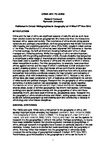Geography of crime
| dc.contributor.author | Yarwood, Richard | |
| dc.contributor.editor | Wharf B | |
| dc.date.accessioned | 2016-02-17T15:40:52Z | |
| dc.date.available | 2016-02-17T15:40:52Z | |
| dc.date.issued | 2015-11-02 | |
| dc.identifier.uri | http://hdl.handle.net/10026.1/4337 | |
| dc.description.abstract |
Crime and the fear of crime are significant aspects of daily life and as such have been studied closely by human geographers who have examined the interactions between crime, space and society. The occurrence of crime shows strong spatial variations and, perhaps unsurprisingly, work by geographers was initially concerned with mapping and explaining patterns of crime (Fyfe 2000), largely in urban centres of the West. The distribution of crime has been explained with reference to theories of human ecology, the built environment, housing markets and forms of urban management, including policing. While the mapping of crime remains important, especially with the growing sophistication of GIS, the sub-discipline has burgeoned to encompass a wider range of theoretical and empirical concerns. Critical theories have been used to question the nature of crime and the extent to which it reflects wider inequalities in society. Feminist geographers, for example, have examined crimes against women and the ways in which it contributes to their exclusion from society, drawing attention to the often hidden crimes committed in private and domestic spaces (Valentine 1989). Others have examined how crime is policed and, increasingly how policing contributes towards the fragmentation and reshaping of public space, often with exclusionary results (Herbert 2011). Related to this, some crimes have also been considered a form of resistance and examined in the context of wider social and political changes. Research into the geography of crime occupies something of a niche position; few geographers, for example, would describe themselves as ‘crime’ geographers and might instead identify with the broader strands urban, social or feminist geographies that inform their studies. Criminology, sociology and spatial statistics overlap with the geographies of crime and these disciplines inform, and have been informed by, geographical study. Research into the geography of crime remains diverse and vibrant, cutting across many areas of social and cultural geography as well drawing upon and contributing to debates in criminology and other related disciplines. | |
| dc.language.iso | en | |
| dc.publisher | Oxford University Press | |
| dc.relation.ispartof | Oxford Bibliographies in Geography | |
| dc.title | Geography of crime | |
| dc.type | chapter | |
| plymouth.organisational-group | /Plymouth | |
| plymouth.organisational-group | /Plymouth/PS - Doctoral College | |
| plymouth.organisational-group | /Plymouth/REF 2021 Researchers by UoA | |
| plymouth.organisational-group | /Plymouth/REF 2021 Researchers by UoA/UoA14 Geography and Environmental Studies | |
| plymouth.organisational-group | /Plymouth/Users by role | |
| plymouth.organisational-group | /Plymouth/Users by role/Academics | |
| dc.publisher.place | Oxford | |
| dc.rights.embargoperiod | Not known | |
| rioxxterms.licenseref.uri | http://www.rioxx.net/licenses/all-rights-reserved | |
| rioxxterms.type | Book chapter |


